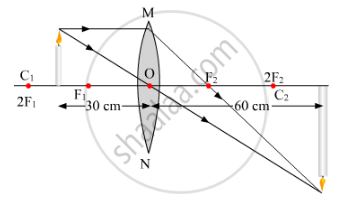Advertisements
Advertisements
Question
The image of a candle flame placed at a distance of 30 cm from a spherical lens is formed on a screen placed on the other side of the lens at a distance of 60 cm from the optical centre of the lens. Identify the type of lens and calculate its focal length. If the height of the flame is 3 cm, find the height of its image.
Solution

Since the image is formed on the screen, the image is real. A concave lens cannot form a real image. Therefore, the lens is convex.
Focal length of the convex lens, f = ?
Object distance, u = ⇒f=20" role="presentation" style="position: relative;" data-mce-style="position: relative;">⇒f=2030 cm
Image distance, v = +60 cm
Since
`1/v-1/u=1/f`
`therefore1/f=1/60-1/((-30))`
`rArr1/f=1/60+1/30`
`rArr1=((1+2))/60`
`rArr1/f=3/60`
`rArrf=20`
Or
f = +20 cm
The magnification of convex lens, `m=v/u`
`rArrm=60/-30`
`rArrm=-2`
`"Magnification, "m=h_i/h_o`
where
hi = Height of image
ho = Height of object
`thereforem=h_i/3`
`rArrh_i=-2xx3`
`rArrh_i=-6`
Here, negative sign indicates that the image formed is inverted.
Therefore, height of image of candle flame is 6 cm.
APPEARS IN
RELATED QUESTIONS
The image formed by a spherical mirror is real, inverted and is of magnification -2. If the image is at a distance of 30 cm from the mirror, where is the object placed? Find the focal length of the mirror. List two characteristics of the image formed if the object is moved 10 cm towards the mirror.
A student wants to project the image of a candle flame on a screen 60 cm in front of a mirror by keeping the flame at a distance of 15 cm from its pole.
(a) Write the type of mirror he should use.
(b) Find the linear magnification of the image produced.
(c) What is the distance between the object and its image?
(d) Draw a ray diagram to show the image formation in this case.
A spherical mirror produces an image of magnification -1 on a screen placed at a distance of 50 cm from the mirror.
(a) Write the type of mirror.
(b) Find the distance of the image from the object.
(c) What is the focal length of the mirror?
(d) Draw the ray diagram to show the image formation in this case.
Linear magnification produced by a concave mirror may be:
(a) less than 1 or equal to 1
(b) more than 1 or equal than 1
(c) less than 1, more than 1 or equal to 1
(d) less than 1 or more than 1
If a magnification of, −1 (minus one) is to be obtained by using a converging mirror, then the object has to be placed:
(a) between pole and focus
(b) at the centre of curvature
(c) beyond the centre of curvature
(d) at infinity
An object of height 6 cm is placed perpendicular to the principal axis of a concave lens of focal length 5 cm. Use lens formula to determine the position, size and nature of the image if the distance of the object from the lens is 10 cm.
A lens forms the image of an object placed at a distance 15 cm from it, at a distance 60 cm in front of it. Find the magnification.
An object is placed vertically at a distance of 20 cm from a convex lens. If the height of the object is 5 cm and the focal length of the lens is 10 cm, what will be the position, size and nature of the image? How much bigger as compared to the object?
A lens of focal length 5 cm is being used by Debashree in the laboratory as a magnifying glass. Her least distance of distinct vision is 25 cm.
- What is the magnification obtained by using the glass?
- She keeps a book at a distance 10 cm from her eyes and tries to read. She is unable to read. What is the reason for this?
The magnification produced when an object is placed at a distance of 20 cm from a spherical mirror is +1/2. Where should the object be placed to reduce the magnification to +1/3.
